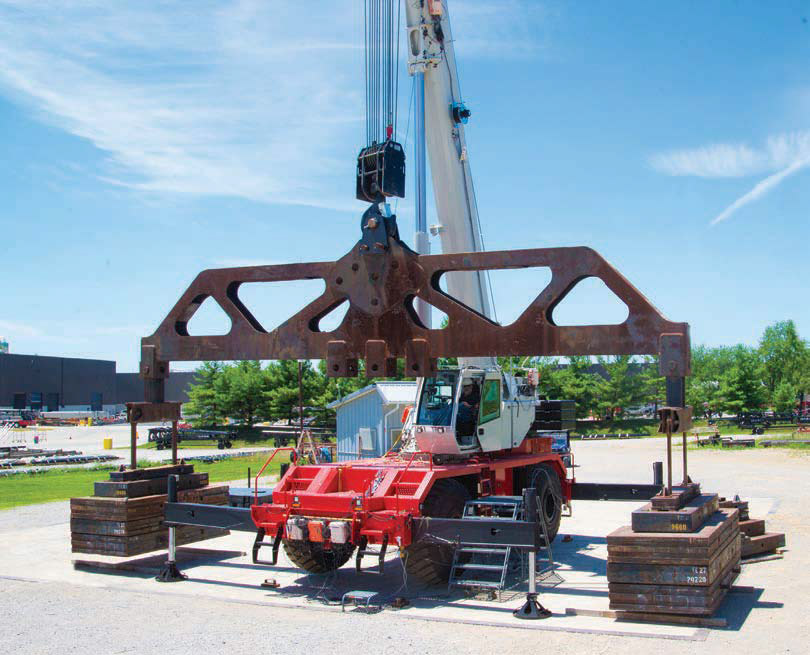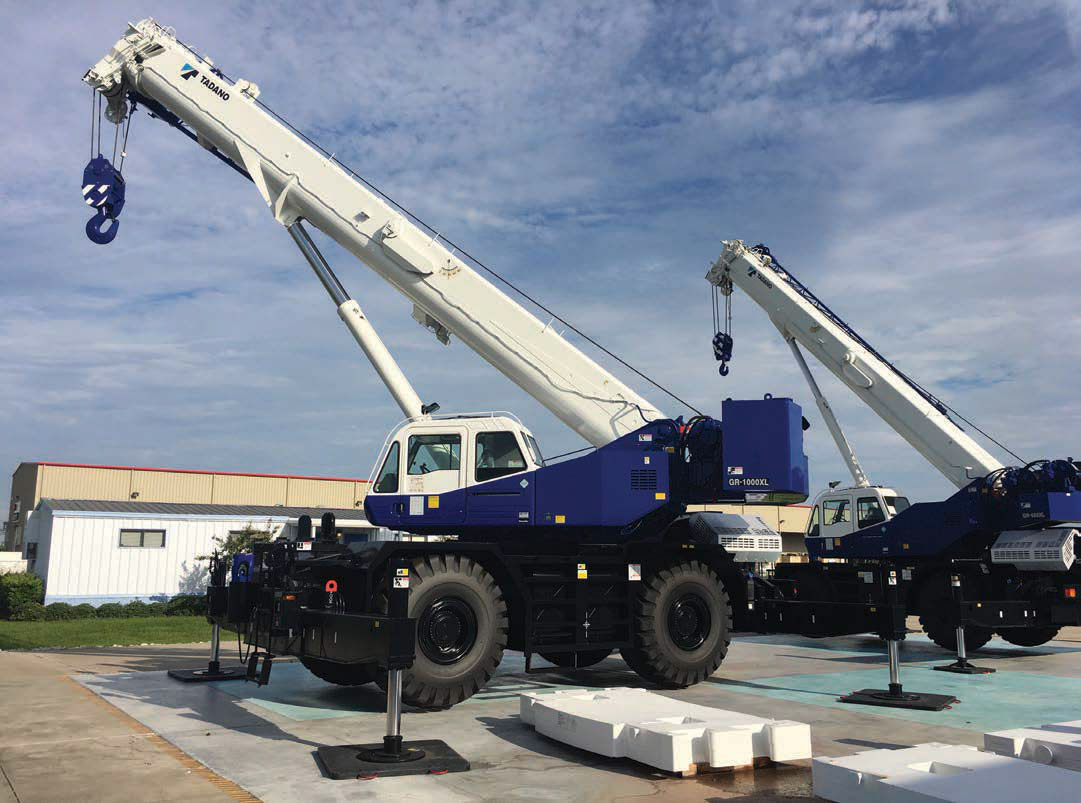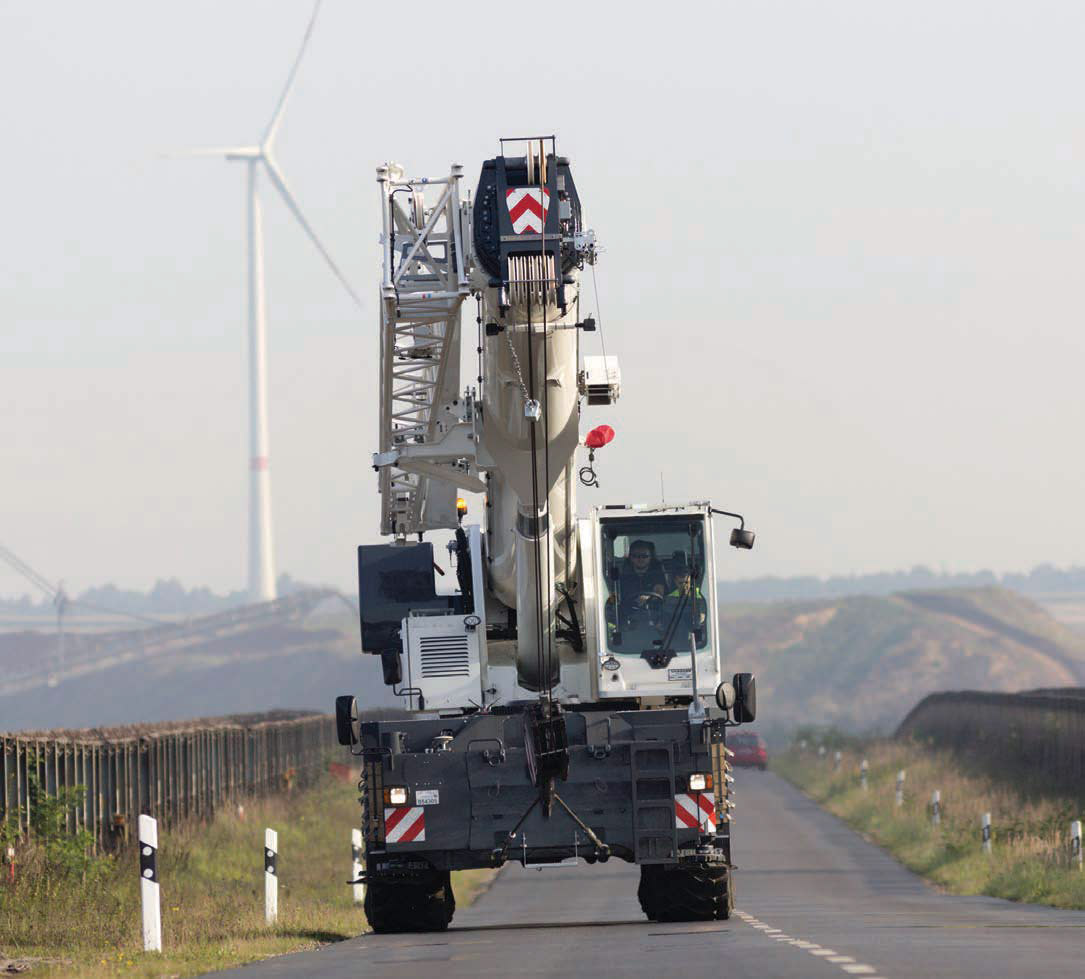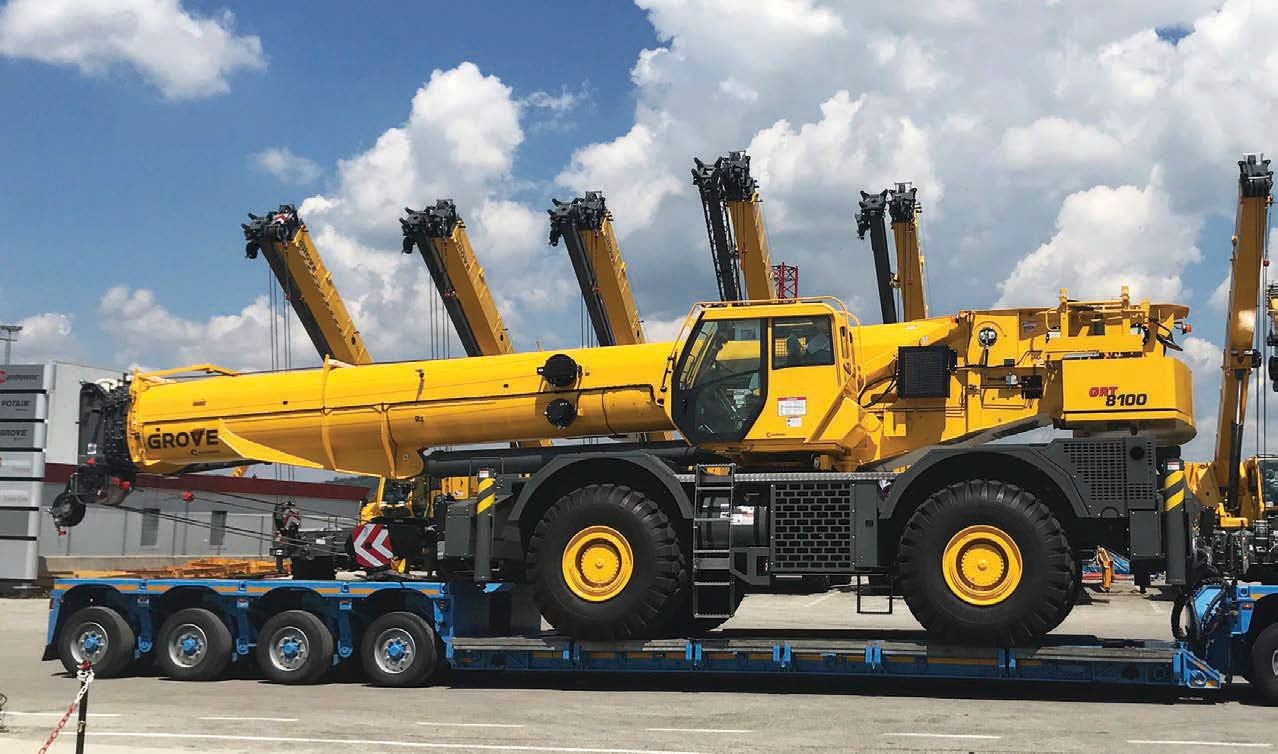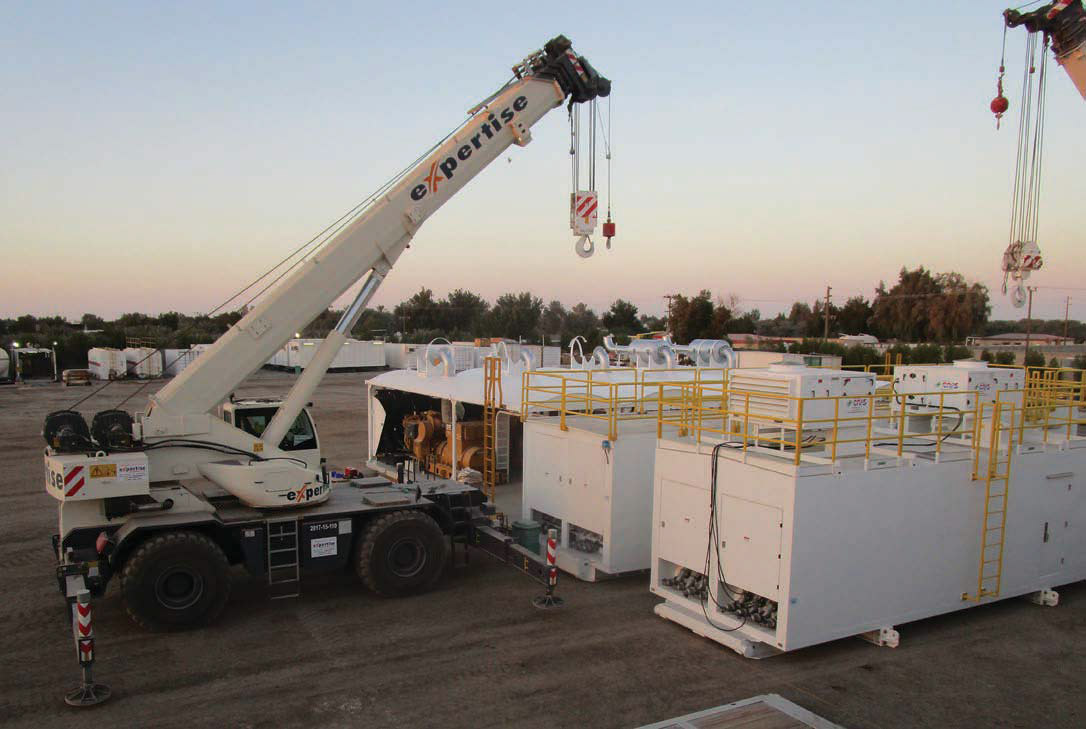The new sweet spot
8 October 2018Rough terrain cranes are getting bigger. With 100USt models now the ‘sweet spot’ in the USA, 100t and 90t models are finding new markets around the world. Julian Champkin reports.
Rough terrain cranes have been creeping up in size. A few years ago 60t or 80t was the top of most manufacturers’ ranges. Now 100t rough terrains are common, and some go even bigger.
Thus Liebherr launched its first two new rough terrains in decades two years ago, and they are both in this capacity range: the 90t LRT 1090-2.1 and the 100t LRT 1100-2.1. Tadano were the first to bring out even bigger models, in the form of its 145t GR-1450EX2 on the European market, with the GR- 1600XL-2 as the US version.
“In the past years, the 80t class used to be a very popular class, not only in North America, but also in the Middle East and the Asia-Pacific region,” says Andreas Cremer, global product director at Manitowoc.
“With customers asking for more performance, this class is reaching now into the 100t rating. You could say the 100t rough terrains are the new 80s.”
This is especially true in North America. “It is certainly fair to say that the US is the leading market for large rough terrains,” he says. “In other regions, when 100t capacity is required usually it is all terrain cranes that are being used.”
These large rough terrains are particularly found in the petroleum and refinery industries. Oil prices are rising: West Texas Intermediate is forecast to increase in price by 30% before winter. The effect of Iranian sanctions is part of the cause, and it is stimulating production in the US and elsewhere. According to the Baker Hughes rig count, the number of rigs operating in North America has risen by more than 10% in the year to August 2018, and worldwide by about 4%. Demand for large rough terrains should therefore be high, particularly in North America.
“In North America, oil has been a historically busy market for rough terrains. Low oil prices have resulted in lower demand for this application, but prices seem now to be recovering from lower levels,” says Dan Melnyk, sales director, North America for Terex cranes.
“We are optimistic about growth in these regions, and have seen positive responses to the RT100US and the RT90,” these being Terex’s parallel US (100USt) and European (90t) offerings in that capacity.
But petrochemicals is far from the only application for large rough terrains.
“These are popular machines,” says Ingo Schiller, president of Tadano America. “Originally they were found in refineries. They have moved across to construction.
Customers tell us they use the larger rough terrains where in the past they would have used an all-terrain crane.
There is an economic tipping point where the capital cost plus cost of transporting the rough terrain, on a semi-trailer or low-loader, measured against the capital cost plus cost of driving the all terrain to the site on its own wheels, starts to pay off. On a short job, the all terrain is cheaper; on a longer job the rough terrain becomes the economical solution.”
“In the US, rough terrains are typically rental cranes and are used in a wide variety of applications ranging from large infrastructure projects and general construction to industrial plants,” says Cremer.
Or as Randy Spike, product manager, rough terrain cranes, Liebherr USA puts it, “The rough terrain in the US has been the dominant lifting platform for many years. It has been called the wheelbarrow of the construction site. US customers are used to its advantages on all types of projects; the rough terrain crane is usually the first in and the last to leave a project.”
Hence part at least of the rationale for those manufacturers who have been adding large (around 100t) capacity rough terrain cranes to their offerings in recent years.
“There has been increased demand for larger capacity classes as high reach and heavier lifts become more common,” says Terex’s Melnyk.
At Liebherr USA they have seen the same trend. “The 100t rough terrain is currently the market sweet spot where demand has been greatest,” says Spike. “We see the demand for rough terrain cranes to be better for the next 18 months.”
Schiller frames the current demand for large rough terrains like this: “The crane industry is full of very intelligent people. They will identify how to do things with greater economy, and with greater convenience, wherever possible.
Rough terrains have been around forever, but every so often they make a generational jump. A few years ago they made just such a jump, to 100t capacities.”
“There is still demand for the smaller rough terrains, of 50t or 80t capacities,” he says. “Those are still produced and purchased. But increasing numbers of people seem to be making the jump to larger machines.”
The demand is worldwide. Melnyk says: “We have seen increased global demand for these products in wind, energy and infrastructure applications. The US, Latin America and the Middle East have been key markets for our rough terrain models in this range. Primary applications are general construction, equipment unloading and placement, steel erection, bridge construction, rental services, drill rig placement and service, and refinery refurbishment and maintenance.”
Schiller says there are more popular and less popular areas for rough terrains. “The more popular are North America, the Middle East, Asia and southern Europe; Northern Europe is an area where they are less used. All-terrain vehicles have more of a hold there and take care of the needs that a large rough terrain would satisfy.”
Tariff effect
A complication in the US market is the effect of the steel tariffs introduced by President Trump, which began taking effect in June 2018. The tariffs apply to raw steel only, not to finished products; so crane makers who manufacture in the US using imported steel could face a considerable price penalty, presumably to be passed on to their customers, compared to those who manufacture elsewhere and import completed cranes into the US.
This of course is the reason for the highly-publicised move by Harley- Davidson to transfer some of their motorcycle production overseas.
Harley announced that the tariffs would add around $2,000 to the costs of a motorbike. Comparing the weight of a motorbike against the weight of a large rough terrain suggests that the impact on cost to US customers of locally built cranes could be significant.
An obvious solution might seem that makers divert Japanese- or European-made cranes, originally destined for other markets, to the US. This, however, is not straightforward. Standards are different, and similar cranes will have subtle differences depending on which market they were designed for. These differences will translate into maintenance, emission and running issues, with different spare part requirements and the like.
Thus Terex launched their RT 90 during Bauma in 2016. In the US, the company started to market the machine as RT 100US in 2017.
“While it is the same platform and both machines are produced in our Crespellano, Italy facility, the RT 90 is designed to EN 13000 standards and the RT 100US is designed to B30.5 standards,” says Melnyk.
Thus they are not interchangeable. Manitowoc, like Terex, has also started rough terrain production in Italy. Their 90t (100USt) rough terrains are sold under the Grove label as the GRT8100, and hitherto have been made at Manitowoc’s Shady Grove facility in Pennsylvania.
In March 2018 the first Italian-made GRT8100 left the production line, destined for the Middle East. The reason for European production, says Cremer, is to be closer to customers.
“The plant, at Niella, has been there for some time. Manitowoc has been producing the self-erector range from Potain, and small rough terrains—the RT530E, RT540E and RT550E—at that plant for some years now, and has assembled twoand three-axle all-terrains there as well. Advantages are lower shipping costs into other regions, shorter shipping times, but also benefits in terms of tariffs when trading out of the EU into countries that have a trade agreement with the EU.”
Whether post-Brexit Britain will fall into that category of ‘countries having a trade agreement with the EU’ no-one yet knows; but the cranes manufactured at Niella will not be sold in the US, again because of differences in national standards.
“Those cranes will not be sold to North America but to the rest of the world, depending on the emissions standards fulfilled.”
Liebherr’s crane customers will be among those exempt from tariff costs—even though Liebherr has started work on a $45m new headquarters in the US, in Newport, Virginia, to incorporate sales, service, repair, and parts capabilities and a modernized production and workshop facility.
It has been manufacturing in Newport for nearly 50 years and has other production sites in the US, but these are for the company’s other product divisions. All their rough terrain cranes are Europeanmade. The rationale for the Newport expansion, says Spike, is that “it will give [Liebherr] another strategic location on the East Coast with sales, service, repair and parts capabilities. For Liebherr it makes sense to produce crawler cranes and all terrain lines in one location at Liebherr-Werk Ehingen in Germany,” he says.
“It makes sense to keep all of the crane manufacturing on one location. The advantage is that when one sector slows down, we can shift production people to another sector to maintain our highly-trained production people. That way we avoid the personnel problems that occur during boom and bust cycles when using separate manufacturing facilities.” An added benefit is that it also of course avoids steel tariffs.
Tadano makes its rough terrain cranes in Japan and has, says Schiller, no plans to change that: “Right now Tadano’s existing factories in Japan, and the new factory it is building at its headquarters in Tahamatsu, will take care of demand for a while.”
Getting bigger still
Tariffs or no tariffs, the demand for large rough terrains will not diminish. There are three main reasons, says Schiller. The first is economic. “The operational cost differences between running a 60t rough-terrain and a 100t rough terrain are negligible. So purchasers will be thinking ‘Why not give ourselves the larger capacity?’”
The second is about customer satisfaction. “Crane owners never want to discourage a customer,” he says. “So if a job is out there that could probably be handled by a 60t machine, and if there is a choice, the thinking is, let’s just put an 80t rough terrain out there, to be on the safe side. That way there will be no issue: the job will get done even if the loads do turn out larger than expected. Go large so there is no risk of disappointing the customer.
“And the third incentive for buying larger rough terrains is to simplify the fleet. There are companies that have rough terrains in the 45t, 50t, 80t and 100t range, and maybe even in the 160t range. A growing number will be wanting to standardise that to a smaller number of models.”
It is a measure which makes sense from all kinds of viewpoints, from ease of maintenance to standardisation of parts and of procedures.
“It is not that the market for smaller rough terrains is decreasing,” says Schiller; “it is that the market for bigger rough terrains is increasing. Construction jobs are getting bigger, especially in the petrochemicals industry and on construction sites where the larger rough terrains find much of their work. Lifts are getting higher, reaches are getting longer.
The projects themselves are not necessarily larger than before, but the components are tending to arrive ready-assembled, rather than being assembled on-site. At refineries and similar places it is the assemblies that are getting bigger, giving larger and larger pieces that need to be lifted into place.”
“We have seen increased global demand for these products in wind, energy and infrastructure applications,” says Melnyk. “We expect to see steady growth over the next 18 months for these products.” And from Cremer: “We continue to see encouraging signs of an impending recovery in the crane market in the US, driven primarily by the energy end market. This could be further escalated if a large infrastructure bill is passed.”
“We introduced the 100t Tadano some years ago,” says Schiller. “Since then we have delivered more than 1,000 of them. I am responsible for the North American market and here they go from the docks where they are unloaded often straight to the worksites. That, with the number of them sold, I think shows that we got it right.
“We spoke earlier of generational steps. The jump to 100t was one of them. The next one came a few years later with the introduction of even larger capacities.
“Tadano brought in the 160t rough terrain some years ago; this size rough terrain was thought to be a niche market. But its popularity has exceeded expectations, with several deliveries each month.”
The current capacity limits will probably not remain: “But generally there needs to be some kind of catalyst in the industry to prompt the next jump and I cannot say what that next catalyst will be.”
“Traditionally you could say that the rough terrain market in the 100t class was mainly in the US, but with the change to higher capacities in general, we will see this class become also more popular in other parts of the world,” says Cremer.
And beyond that? Technology increases in all automotive machinery and rough terrain cranes are no exception. “Due to improvements in everyone’s manufacturing processes, the general lifespan of cranes has increased over the last few years,” says Schiller. “It was common for first owners to hold on to their machines for six to eight years; now it tends to be eight to ten, and for Tadano machines, which we like to think have a reputation for reliability, ten to twelve years is a reasonable expectation.
“Outdating is one of the tensions in the industry. Customers want improvements as technology advances, but they do not want a lot of changes and new models.
Each time a new model comes in, it downgrades the value of all the fleets of older models. So Tadano attempts to maintain models and keep them current as long as possible. It is very disciplined about product introduction.
“Anything that goes up needs a crane. Of course big rough terrains cost money, but people are getting a return on them. If you do the calculations about which type of crane to deploy, for very many tasks the cost per lifting capability (which includes reach and height) works out to be less with an rough terrain. So you make a decision on which to deploy.”
So the industry will probably continue to buy large rough terrains. Bigger would seem to be better.
Long, formed, and full-powered
As this article was being written, Link-Belt announced it is bringing a new 100USt (90t) 100RT rough terrain crane to the market with, according to the manufacturer, the longest full-power boom available.
The five-section, 40.6–155ft (12.3–47.2m) full-power formed boom is built to Link-Belt’s specific boom profile and tolerances at its Lexington, Kentucky campus.
An available two-piece (35–58ft) on-board offsettable fly provides greater flexibility, and manually offsets at 2°, 15°, 30° and 45°. A 16ft lattice insert extension provides a maximum tip height of 237ft.
The 100RT will be the first Link- Belt rough terrain crane to utilize the new fly erection technology from Link-Belt’s latest telescopic truck and telescopic crawler cranes.
A fly assist cylinder makes erecting and stowing the fly a oneperson operation and minimizes work at height. Boom head speed screws and numbered spring loaded latches provide intuitive assembly. Given the natural elevation of a rough terrain crane boom, Link-Belt has simplified fly assembly with new ground level carrier controls. One control raises and lowers boom angle from 0 to -3°, and another control is used for the fly assist cylinder.
Other notable features for the 100RT include Link-Belt’s latest operator cab design, Pulse 2.0 operating system with remote software updates via Wi-Fi, V-Calc asymmetrical outrigger options, a new simple-to-assemble fly, latest Cummins technology with a Stage V engine, and Link-Belt’s Vision package.
The 100RT will transport with base unit fully equipped minus modular counterweights at 92,859lbs (42,120.1kg). With an overall height of 12ft 10in this rough terrain can be driven right off a conventional lowboy trailer, assemble its counterweight and be ready to go to work.
Following rigorous on-site and field testing, shipments of the new 100RT are scheduled to begin first quarter 2019.
